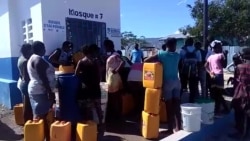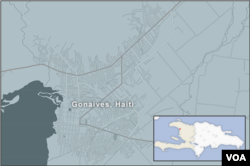Christmas came early, in the form of a brand new potable water kiosk, to two villages - Jerusalem and Canaan - in Gonaives, a town with a population of about 300,000 people in Haiti's north.
On a sunny morning, a group of people, most of them women, gathered with bright yellow, blue, and white plastic receptacles to fill with drinkable water flowing freely from a series of shiny faucets. The residents, who don't have running water at home, were excited.
"I'm so happy; I come here three times a day," a woman told VOA Creole. She said the faucet they were previously using was an old pump that required a lot of work before the water would come out.
Four-year process
The project, financed by France's Agency for Development, AFD, cost about $1.7 million (USD) and took four years to build. The project was a collaboration with Haiti's National Potable Water and Sanitation Agency, DINEPA. Why did it take so long? DINEPA engineer Guito Edouard offered answers.
"At the DINEPA level, we have to go through a process before starting a potable water and sanitation project," he said as the kiosk was used for the first time.
"First, there was a study, then we examined what type of study it was, we had to find funding, we had to sit down with the donor to explain our approach to the project, because sometimes, when DINEPA receives government funds for a project it's not enough - they (the Haitian government) gave $13,000 (USD) - and you'll notice that our project in Gonaives cost over $1.7 million (USD)," he said.
Project beneficiaries
Twenty-thousand residents will benefit from the new access to potable water. The system is capable of storing 650 cubic meters, which is equal to about 171,600 gallons of water, the DINEPA engineer said.
The local hospital is also a beneficiary. A newly-installed water tank on its roof has a capacity for 100 cubic meters of water.
"What we've learned from our experiences in Haiti and the 100 other countries where AFD has projects, is that the success of our water and sanitation projects depends on the methodology used to implement it and the effective participation of the beneficiaries of the service," AFD director Anna Lipchitz said.
Criticism and praise
"Ah, I don't like this story - it makes Haiti seem like a really poor country in the 21st Century - it's a bad image" a person commented on VOA Creole's Instagram post about Gonaives' water kiosk. "And that it took foreigners," he said, adding, "The French who stole a lot of our money under previous presidents - I don't like it at all."
Others praised and thanked the French for doing what the Haitian government failed to do and suggested additional locations that would benefit from water projects.
Back at the kiosk, villagers were telling local officials how grateful they were for the fresh water. "Now we need electricity and a medical center," one villager said.
Haiti is the Western Hemisphere's poorest country.








